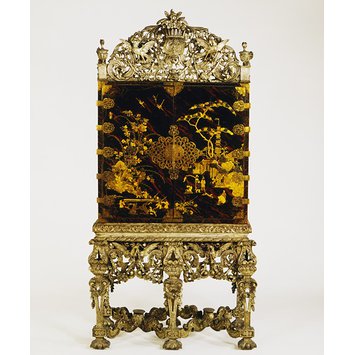Germany at this time was made up of over 300 principalities, loosely bound into the Holy Roman Empire. Only three of the German states were large enough to compete as powers on a European scale - Bavaria, Saxony, and Brandenburg-Prussia. The princely rulers vied with each other for power and prestige, building magnificent Baroque palaces and Rococo pavilions at enormous cost.
French Influence
The most clearly defined German styles of the time were Bavarian and Frederician Rococo. Under the patronage of Maximilian II Emanuel, Elector of Bavaria, and King Frederick the Great of Prussia, architects and cabinet makers were encouraged to take inspiration from France.
A French designer of particular significance was Francois Cuvillies, who was employed by the Elector of Bavaria. Cuvillies' spectacular interiors at the Residenz and the Amalienburg Pavilion in Munich represent the height of German Rococo. Swirling, gilded, carved wooden decorations covered the walls and
handmade furniture of Cuvillies' interiors, with motifs ranging from pure rocaille to sculptural figures, masks, and animals.
German Rococo
Early 18th century German furniture and
fitted furniture was heavier in style than French or Italian pieces. Commodes and cabinets, in particular, were massive and were decorated with typical Rococo motifs, such as scrolls, shells, cartouches, and fantastic foliage.
Enormous bureau-bookcases were serpentine in shape and had scrolled legs and tiny scrolled feet. Glass-fronted display cabinets were painted in pale Rococo colours and gilt, and decorated with shells, foliage, and scrolls - commodes had exaggerated curves.
As in France, furniture, usually carved and gilded or painted, was designed for an integrated interior. Special rooms or themes, such as the garden, often influenced the decoration. The desire for informality inspired new types of furniture. Fire screens, couches and settees, writing tables, and carved and gilded console tables were made for the wealthy.
Typical 17th century furniture, now
reproduction furniture, such as the two-part cupboard and the wardrobe, was still made well into the 18th century. Carving tended to emulate French boiserie panelling, and great emphasis was placed on the woods chosen for veneers.
Walnut, engraved ivory, fruitwood, sycamore, and green-stained softwoods were used for both marquetry and veneers. Lacquerwork was still popular, and exquisite cabinets and tables, often made in Berlin, were decorated with fashionable Chinoiserie patterns and fetes galantes.
Unlike French furniture, which is usually stamped with the makers name, German furniture of this period is rarely attributed to specific makers. This is because in Germany at this time, the best cabinet makers were employed by the Courts and worked directly for their employers. They lived in the grounds of palaces, had their workshops there, and were often salaried.
German Commode
The commode presented here has two drawers and a rare décor featuring a Chinese-style European lacquer. The façade and sides have panels with a so-called “vermillion” background highlighted with gilt motifs of landscapes filled with figures, pagodas, and birds, contrasting with the black lacquer frame that sets them off. It has an brèche d’Alep marble top. Very few examples are known of furniture featuring these two tones, red and black. Among those that have been identified: a commode stamped “BVRB” with a black background panel set within a red frame, in the Hôtel de Boisgelin, the current Italian Embassy in Paris and a second one, with red background panels in a black frame, stamped by Jean Desforges, is reproduced in Wolvesperges. And finally, special mention for a commode can be seen in the famous gouache by Louis-Nicolas Van Blarenberghe, depicting the view from the bedroom of the Duc de Choiseul à Paris.
Cabinet On Stand
This cabinet is japanned in an oak carcase, with softwood dustboards and oak drawer linings - the stand and cresting of carved and silvered softwood and lime.
After 1660, cabinets on stands were considered particularly prestigious pieces of furniture. They were highly decorated and contained many drawers for valuable and unusual objects. They were also objects of display in their own right. This cabinet has been 'japanned'. Japanning was a decoration that imitated lacquer made in East Asia. Professional craftsmen carried it out, and it also became a popular pastime for wealthy women. The taste for silvered, wooden furniture in England derived from furniture actually made in silver for the French court of Louis XIV (ruled 1643-1715). Very little of this survives, because Louis had it melted down to pay for his military campaigns. It is rare for such ornate crestings to remain complete. This cabinet belonged to Sir Richard Hill (1655-1727), who became Deputy Paymaster to William III's forces in Flanders.






